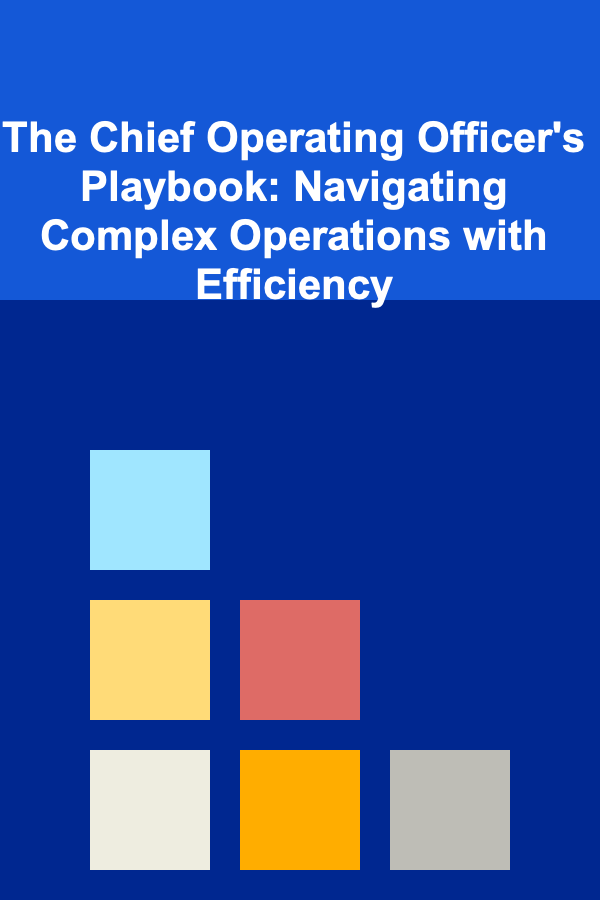
The Chief Operating Officer's Playbook: Navigating Complex Operations with Efficiency
ebook include PDF & Audio bundle (Micro Guide)
$12.99$7.99
Limited Time Offer! Order within the next:

The role of the Chief Operating Officer (COO) is often one of the most dynamic and multifaceted positions in any organization. Tasked with overseeing daily operations, driving efficiency, and ensuring that the company's strategies are implemented effectively, the COO is the key individual responsible for transforming high-level strategies into smooth, operational processes. But as organizations become more complex, the role of the COO becomes even more critical, requiring a nuanced understanding of operational efficiency, leadership, and technology.
This actionable guide is designed for current and aspiring COOs to help navigate the complexities of modern operations, streamline workflows, and implement efficient systems that drive long-term success.
Understanding the Complex Role of the COO
The Chief Operating Officer is often the second-in-command after the Chief Executive Officer (CEO) and works closely with the executive team to translate the company's vision into actionable plans. While the specific responsibilities may differ depending on the size, structure, and industry of the organization, the core function of the COO revolves around managing and optimizing the operations that are necessary for a business to thrive.
The COO typically oversees several operational areas, including:
- Operational Strategy: Aligning daily operations with the broader strategic goals of the organization.
- Process Optimization: Identifying and improving business processes to maximize efficiency.
- Resource Management: Ensuring optimal use of both human and technological resources.
- Cross-Departmental Coordination: Ensuring that different teams and departments work collaboratively and cohesively.
- Change Management: Leading the company through times of change, whether due to growth, market shifts, or technological advancements.
Mastering the COO role is not just about day-to-day management but requires forward-thinking and innovative strategies. Below are several actionable steps and strategies for COOs to navigate complex operations effectively.
Mastering Operational Efficiency
Streamlining Processes and Systems
One of the most important tasks for a COO is identifying inefficiencies within existing systems and processes. Inefficiencies---whether they're in communication, supply chain management, or internal workflows---can lead to higher costs, reduced productivity, and missed opportunities.
Actionable Steps:
- Conduct a Process Audit: Regularly review existing processes to identify areas that can be improved. This audit can be performed using tools like process mapping, value stream analysis, or flowcharts to visualize workflows.
- Embrace Lean Methodologies: Lean practices, which focus on eliminating waste and maximizing value, should be embedded into the company's culture. Techniques such as Kaizen (continuous improvement) and Just-in-Time (JIT) manufacturing can drastically improve efficiency.
- Standardize Operations: Standard operating procedures (SOPs) are key to ensuring consistency across departments. SOPs provide clear instructions for tasks, reducing mistakes and enabling scalability.
Automating Routine Tasks
Repetitive tasks that do not require significant decision-making or human intervention are prime candidates for automation. The implementation of automation tools allows staff to focus on higher-value work, such as strategy development, relationship management, and customer engagement.
Actionable Steps:
- Automate Administrative Tasks: Use software like Zapier, Microsoft Power Automate, or IFTTT to automate tasks such as data entry, report generation, and email responses.
- Integrate Software Systems: Implementing tools like ERP (Enterprise Resource Planning) systems, such as SAP or Oracle NetSuite, allows various departments---sales, HR, finance, etc.---to work from a single data set, improving data flow and reducing manual input.
Leveraging Technology for Scalability
In the modern digital age, the role of technology is paramount in driving operational excellence. The right technological tools can enhance communication, streamline supply chains, and enable data-driven decision-making.
Building a Robust Tech Stack
A well-integrated tech stack supports operational activities and helps eliminate silos within the organization. The COO should focus on building a tech ecosystem that supports scalability, transparency, and agility.
Actionable Steps:
- Evaluate and Adopt Cloud Solutions: Cloud-based tools like Google Workspace, Microsoft Teams, or Slack enhance collaboration and accessibility. They allow teams to work together regardless of location, making them essential for modern businesses.
- Implement Advanced Analytics: Business intelligence (BI) tools such as Tableau or Power BI allow the COO to make data-driven decisions. Real-time analytics dashboards give insights into operational performance, enabling the leadership team to pivot quickly when needed.
- Adopt AI and Machine Learning: Artificial intelligence and machine learning can optimize complex operations, such as supply chain forecasting, predictive maintenance, and customer service automation. Implementing these technologies can dramatically reduce costs and improve efficiency.
Real-Time Data Access
Having access to real-time data is essential for making informed decisions. Whether it's monitoring customer behavior, tracking supply chain movement, or assessing employee performance, data can inform strategy and operational adjustments.
Actionable Steps:
- Implement IoT for Real-Time Monitoring: The Internet of Things (IoT) can provide real-time monitoring of various operational aspects, such as inventory levels, machinery performance, or delivery status. Sensors and devices can provide data streams that alert teams to issues before they escalate.
- Use Predictive Analytics: Predictive analytics can be used to forecast demand, customer preferences, and inventory needs. Tools like SAS or IBM Watson provide COOs with the ability to anticipate challenges and opportunities with greater accuracy.
Managing Resources with Precision
Resource management---whether human resources, financial assets, or physical inventory---is at the core of operational efficiency. The COO must ensure that resources are allocated optimally to support the organization's goals.
Workforce Optimization
A skilled, motivated, and well-equipped workforce is essential for operational success. The COO must manage the team effectively by fostering a culture of accountability, collaboration, and continuous learning.
Actionable Steps:
- Skill Development Programs: Implement ongoing training and development programs to ensure that employees have the skills needed to operate effectively in a modern, tech-driven environment. This might include leadership training, technical certifications, or cross-functional training.
- Succession Planning: Ensuring that there's a clear succession plan for key leadership positions allows the organization to be resilient to turnover or unexpected departures.
- Improve Employee Engagement: Tools like Officevibe or TINYpulse allow COOs to measure employee engagement and gather feedback that can help optimize team performance.
Financial Management
The COO is responsible for ensuring that operational budgets are adhered to and that resources are being spent wisely. Financial efficiency is critical for maintaining profitability, especially as organizations scale.
Actionable Steps:
- Monitor Operational Costs: Regularly analyze the company's financials to track where money is being spent across different departments. Use financial software like QuickBooks or Xero to track expenses and look for opportunities to reduce costs.
- Invest in High-Impact Areas: Prioritize investments in areas that will deliver measurable returns, such as technology upgrades, marketing initiatives, or customer service improvements.
Supply Chain Optimization
A well-oiled supply chain is crucial for ensuring that the organization can deliver products or services on time and within budget.
Actionable Steps:
- Streamline Inventory Management: Use tools like TradeGecko or NetSuite to track inventory levels, reducing the risk of overstocking or stockouts. Having real-time access to inventory data helps ensure smooth operations.
- Forge Strong Supplier Relationships: Maintain transparent and collaborative relationships with suppliers. Regular performance evaluations and open lines of communication foster reliability and allow for better problem-solving when challenges arise.
- Diversify Supply Chain Risks: Prepare for potential disruptions (natural disasters, geopolitical issues) by diversifying suppliers and creating contingency plans that enable the organization to adapt quickly.
Leading Through Change and Crisis
In a rapidly changing world, the COO must be prepared to lead the organization through periods of uncertainty. Whether it's responding to a market shift, dealing with an operational crisis, or managing growth, effective crisis management is a key competency for COOs.
Preparing for Change
Successful COOs proactively prepare their organizations for change by creating a culture of flexibility and resilience. This involves developing systems and mindsets that can adapt quickly to new circumstances.
Actionable Steps:
- Develop Change Management Plans: Establish clear frameworks for managing change. This includes identifying key stakeholders, setting expectations, and creating communication strategies to ensure smooth transitions.
- Agile Operations: Encourage cross-functional teams to embrace agile practices, allowing them to respond quickly to market changes or new opportunities.
- Crisis Response Framework: Build a crisis management plan that addresses potential disruptions. Ensure that all key personnel understand their roles in crisis situations, from communication to decision-making.
Cultivating Leadership and Accountability
The COO's role also involves leading teams effectively, establishing clear accountability structures, and ensuring that the organization remains focused on its operational goals.
Actionable Steps:
- Set Clear Goals and Expectations: Clear communication of goals and expectations ensures that all team members are aligned with the company's objectives. Use tools like Asana or Trello to manage project timelines and track progress.
- Foster Accountability: Create a culture where employees take ownership of their tasks and results. Implement performance review systems to provide regular feedback, reward achievements, and address underperformance.
- Encourage Collaborative Leadership: Encourage a leadership style that promotes collaboration and open communication across departments. By fostering teamwork, the COO can ensure that different operational areas are aligned and moving towards the same objectives.
Conclusion
Navigating complex operations with efficiency is the hallmark of a successful Chief Operating Officer. By focusing on optimizing processes, leveraging technology, managing resources effectively, and leading with purpose, COOs can steer organizations toward long-term success. With the right mindset, tools, and strategies, a COO can transform operational challenges into opportunities for growth, innovation, and competitive advantage.
Reading More From Our Other Websites
- [Organization Tip 101] How to Prepare Your Fishing Gear for Travel
- [Personal Care Tips 101] How to Make Your Hair Smell Fresh with Dry Shampoo
- [Home Staging 101] How to Maximize Space in a Small Home with Staging
- [Home Party Planning 101] How to Organize a Themed Potluck Party at Your House
- [Personal Finance Management 101] How to Start an Emergency Fund from Scratch
- [Personal Care Tips 101] How to Make Body Lotion Work for Your Skin's Specific Concerns
- [Digital Decluttering Tip 101] Tools and Apps That Automate Unsubscribing: Save Time and Reduce Clutter
- [Home Family Activity 101] How to Set Up a Family Home Olympics for Bonding
- [Skydiving Tip 101] From Gear to Grace: A Beginner's Guide to Fun Skydiving Sessions
- [Scrapbooking Tip 101] Best Ideas for Incorporating Pressed Flowers --- A Gentle Guide to Preserving Their Beauty

How to Create a Festive Atmosphere in Small Spaces
Read More
How to Keep Your Recipe Books Neat and Damage-Free
Read More
The IT Support Specialist's Playbook: Essential Tools for Efficient IT Support
Read More
How To Build a Strong Vocabulary in Young Children
Read More
10 Tips for Automating Your Performance Management Planner
Read More
How to Track Petty Cash for Remote Teams: Best Tools & Methods
Read MoreOther Products

How to Create a Festive Atmosphere in Small Spaces
Read More
How to Keep Your Recipe Books Neat and Damage-Free
Read More
The IT Support Specialist's Playbook: Essential Tools for Efficient IT Support
Read More
How To Build a Strong Vocabulary in Young Children
Read More
10 Tips for Automating Your Performance Management Planner
Read More